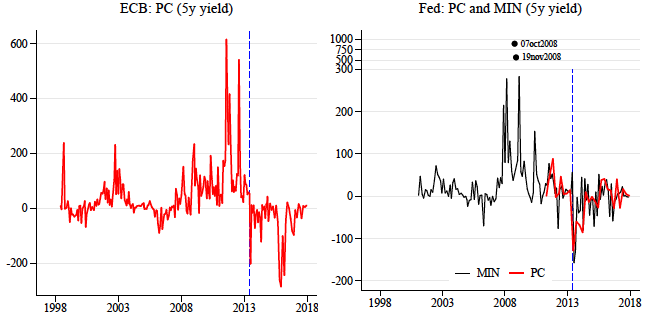On 26 July 2012, Mario Draghi promised to do “whatever it takes” to preserve the euro. His speech is commonly seen as a game-changer during Europe’s sovereign debt crisis, and a powerful example that non-monetary news matters.
On Draghi’s promise, yields on periphery sovereign bonds fell, European stocks and other risk assets rallied, and yields on traditional safe havens such as German bunds decompressed. At the same time, money market rates in the euro area barely moved. Clearly, Draghi’s words influenced asset prices through quite different channels from those of conventional monetary policy.
The multifaceted nature of the news that central banks convey is well established. In an influential paper, Gürkaynak et al. (2005) showed that central bank statements reveal information not just about the policy rate target – the very short end of the yield curve – but also about the expected path of future rates. But research still debates the exact channels through which future rates are affected. Campbell et al. (2012) argue that the Fed telegraphs its projections for the state of the economy to the public, as opposed to conveying pure monetary news. In this view, it is the market’s growth expectation updates which drive short-rate expectations embedded in longer-term maturity bonds. Hanson and Stein (2015) disagree. They argue that monetary policy affects risk premia and thus can exert a significant effect on longer-term interest rates.
Dissecting the type of news in central bank communication
In our recent work (Cieslak and Schrimpf 2018), we propose a new methodology to examine the news content of central bank communication. We exploit the direction of the co-movement between equities and government bond yields, as well as the effect of news across the maturity dimension of the yield curve.
To identify different types of monetary versus non-monetary news, we build a stylised macro-finance model that delivers the following predictions on how different news types impact stocks and yields:
- A conventional monetary policy shock, by affecting the real rate, induces a negative co-movement of stocks and yields that is stronger at short maturities.
- In contrast, both growth and risk premium shocks produce a positive co-movement of stocks and yields. Their effects, however, differ in the maturity dimension. Growth shocks have a greater bearing on the short-to-intermediate segment, whereas risk premium shocks affect more the long portion of the yield curve.
While the effects of growth and monetary shocks are standard, the positive co-movement of stocks and yields via the risk premium channel arises when nominal bonds hedge bad economic times, as was the case from late 1990 to 2017, which is the period we study.
The key predictions can be summarised in what we call the 'central bank news classification matrix' (Figure 1), which classifies events according to the direction of the stock-yield co-movement, and the effect on yield volatilities at short and medium, versus long, maturities.
Figure 1 The central bank news classification matrix
Source: Cieslak and Schrimpf (2018).
Based on this classification, it is also possible to break down monetary policy shocks into conventional and unconventional types. Unconventional shocks – quadrant (2, 2) in Figure 1 – are events that move stocks and yields in opposite directions (like a conventional monetary policy shock) but generate more volatility at long maturities (like a risk premium shock). We find that such effects are more important with the advent of quantitative easing (QE) policies, when central banks have sought to directly affect long-term maturities via asset purchases.
We implement these ideas by directly measuring the co-movement of stocks with the entire yield curve at the level of each single communication event. Based on high-frequency data, we construct the term structure of realised stock-yield covariances, that is, covariances of stock returns with changes in yields of different maturities. The sign and the maturity pattern of those covariances allow us to determine the dominant piece of news revealed across a variety of communications.1
A granular dataset of central bank communication events
We use nearly 2,000 time-stamped monetary policy events from the four leading central banks – the Fed, the ECB, the Bank of England and the Bank of Japan – from the late 1990s to the end of 2017. Our event classification distinguishes between different communication tools, including statements of monetary policy decisions, press conferences and minutes of policy meetings.
The non-monetary component dominates more than half of the communication events in our dataset. There are significant differences in news composition across communication tools, and a distinct shift in the relative importance of non-monetary news over time.
The left-hand panels of Figure 2 report the frequencies at which we observe monetary and non-monetary shocks for the Fed and the ECB, separately for different event types. The right-hand panels illustrate the economic magnitudes, measured by the average stock-yield covariance.
Figure 2 Quantifying monetary against non-monetary news in central bank communication
Source: Cieslak and Schrimpf (2018).
Notes: Communication events include monetary policy decisions (MPD), press conferences (PC), minutes (MIN) and other events, for example key speeches. Left-hand panels report frequencies of events where a given news type dominates. Right-hand panels show average realised covariances, in basis points squared, by event and news type.
Figure 2 shows several parallels between the Fed and the ECB:
- Conventional monetary news – in Figure 1, quadrant (1, 2) – dominates the market’s reaction in more than half of monetary policy decision announcements (left-hand panels of Figure 2). These shocks are also the most significant channel, economically and statistically, when gauged by the magnitude of the stock-yield covariance (right-hand panels of Figure 2). Growth news – quadrant (1, 1) – ranks second by both frequency and economic importance, and accounts for approximately one-third of monetary policy decision announcements. For monetary policy decisions of the ECB, the conventional monetary channel is economically by far the most significant.
- Conventional monetary news plays a smaller role for communication that provides context to the policy decision, in particular in press conferences and minutes. Growth news dominates in more than 50% of those cases. This finding is particularly relevant for the ECB, for which the economic significance of press conferences has been large relative to monetary policy decision announcements.
- Risk premium shocks (2, 1) and unconventional monetary shocks (2, 2) are less common, less than 20% of events each. Though infrequent, these shocks have a significant impact on asset prices, and their importance increases with the implementation of unconventional monetary policy. For example, for the Fed, the large negative covariance in the unconventional policy quadrant (2,2), shown in the top right-hand panel of Figure 2, stems from announcements of the first phase of large-scale asset purchase programs.
The changing importance of non-monetary news over time
The news content of central bank announcements varies over time, especially for those communications whose goal is to provide context to policy decisions. Figure 3 displays the stock-yield co-movement around press conferences and the release of minutes.
The average co-movement switches sign from positive to negative in the middle of 2013, at about the time of the 'taper tantrum'. One interpretation is that Chairman Bernanke’s remarks on the tapering of asset purchases led market participants to turn their focus away from monitoring economy-related news, and toward news about the future direction of monetary policy. We find that announcements related to policy tightening by the Fed induced negative co-movement of stocks and yields.
Figure 3 Shifts in the importance of non-monetary news over time
Notes: The figure plots realised covariances of 5-year yield changes with stock returns in a (-15, +90)-minute window around press conferences (PC) and minutes (MIN). The vertical axis measures basis points squared. The vertical dashed line on 22 May 2013 indicates the 'taper tantrum'.
Implications
Our approach to classifying the content of central bank communication is important for understanding the transmission of monetary policy to asset prices and the broader economy. Usually, the transmission analysis relies on monetary shocks identified using responses of short-term rates. To the extent that central bank announcements also convey news about the state of the economy and can affect risk premia, this identification can both be restrictive and can conflate monetary shocks with other information.
Our results suggest that caution needs to be exercised when measuring monetary policy shocks by lower-frequency (daily) responses of interest rates. For example, policy decision announcements are now commonly followed by a press conference. The news content of those two communication types can be different, despite their proximity. The optimal design of communication by central banks remains an important question to be addressed in future research.
Authors’ note: The views expressed in this column are those of the authors and do not necessarily reflect those of the Bank for International Settlements.
References
Campbell, J, C Evans, J Fisher and A Justiniano (2012), “Macroeconomic effects of FOMC forward guidance”, Brookings Papers on Economic Activity, Spring: 1–54.
Cieslak, A and A Schrimpf (2018), “Non-monetary news in central bank communication,” NBER working paper 25032.
Gürkaynak, R, B Sack and E Swanson (2005), “Do actions speak louder than words? The response of asset prices to monetary policy actions and statements”, International Journal of Central Banking 1: 55–93.
Hanson, S and J Stein (2015), “Monetary policy and long-term real rates”, Journal of Financial Economics 115(3): 429–48.
Endnotes
[1] We also use another, complementary, empirical strategy motivated by the literature on structural VARs, which allows each eventto be decomposed into the contributions of distinct shocks. We achieve identification by imposing two types of restrictions: sign restrictions on the co-movement of stocks and yields, and monotonicity restrictions along the yield curve. We use this approach to assess the amount of variance in equities and yields stemming from monetary and non-monetary channels.






